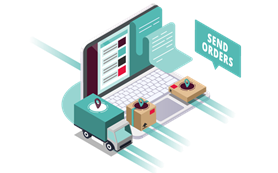
What is an order management system?
Whether you’re a third-party logistics (3PL) company, fulfilment house or an online retailer, cloud-based order management software should be a vital part of your organisation that can make or break your customer experience.
So, how do you ensure this excellent level of customer experience in the modern world? You may find what your business needs is an order management system (OMS).
What is an order management system? Well, from order fulfillment and warehouse management to analytics and reporting, order management software can remove the complexity of multiple, aligned processes, and streamline everything for your business.
So, what exactly is an OMS and are they necessary to help scale your business? In our ultimate guide to an order management system, we’ll explore Order Management Systems, their benefits, and how they work. Once you’ve read this article, you’ll have a better understanding of order management software and how it can transform your e-Commerce operations.
 7 mins
7 mins
Written by Kit Morris
Order management systems
- What is an Order Management System (OMS)?
- What are the common features of an OMS?
- Why is an Order Management System important?
- Benefits of an Order Management System
- The challenges of an order management system
- Types of order management systems
- How to choose the right OMS for your business
- Conclusion
What is an Order Management System (OMS)?
An Order Management System provides eCommerce businesses with a single platform to manage, organise and automate their order management processes. An OMS is designed to simplify purchasing for customers and make it easier for businesses to track and manage their orders, fulfillment, inventory and returns.
Once a consumer clicks 'Buy' and payment has gone through, it is expected the purchased item will be delivered as fast as possible without any problems. Efficient order management software can help businesses manage your order management lifecycle work in a structured way. All users within the order management system can access the information they need about the order fulfilment process to do their part of the job.
What are the common features of an OMS?
In this section, we’ll walk you through the key order management software features:
Order tracking
An effective OMS streamlines processes for both customers and vendors. Handling and collating orders to regular updates on the progress of shipment are some of the most important basic functions. Having one place to look for inventory levels, order information, and customer details makes a huge difference to efficiency and productivity. order management process
Inventory management
An OMS holds stock levels for fulfillment points. Overselling and overstocking are common issues when you cannot accurately measure inventory. With accurate numbers, you can forecast and understand customer order demands allowing you to prioritise your efforts.
Order fulfillment
This involves finding the stock, packaging it, arranging for the best delivery options and attaching labels for shipment from the warehouse to the customer. With an OMS, you'll know how long the package will take to arrive, where problems arise, and prevent lost packages.
Returns
Nobody is thrilled with the idea of returns; however, by utilising a single software system, packages can easily be resent or refunded with minimal disruption to both the vendor and the customer.
Why is an Order Management System important?
An effective order management solution is necessary to fulfil and ship orders at the level that the market now expects. Order management software is also pivotal for staying ahead of competition.
Businesses relying on spreadsheets and disjointed systems to update incoming orders and outgoing deliveries are working to inefficient and time-consuming processes for their operations. Tackling the day-to-day business in this way also increases the potential for errors and delays, which can have a huge effect on the customer experience.
Rather than wasting valuable time completing these order management processes manually, businesses who are looking to grow should turn to OMS solutions to automate and streamline their daily activity.
Benefits of an Order Management System
Implementing a B2B order management system will create many benefits for your business operations, allowing you to stay ahead of the competition and keep up with the demands of an ever-increasing digital world.
Best practice OMS software is designed to make everything as efficient, cost-effective and automated as possible.
In this section, we’ll explore the key benefits of order management system:
Built for flexible growth
Integrations between independent functions create a smooth and seamless operation. These systems are designed to be scalable, and the interface used throughout the journey can change to fit the user's needs.
Streamlined for synergy
An OMS connects and communicates real-time data from carriers, drop-ship locations, suppliers, and more, ensuring every member of your supply chain can operate efficiently and effectively.
Improved customer satisfaction
Transparency in the shipping process and fulfillment means customers have a better understanding of their order status. They'll know when their package is being received, shipped, and delivered, and any issues or delays that may crop up during these processes. Customer support can also be integrated into the OMS, meaning customer service teams can access cart and order history.
Insights into bestsellers
You can even use the software to uncover crucial statistics and insights showing product and marketplace popularity - allowing you to see the areas needing attention or worth investing. It also helps you discover any unusual trends that might arise so that you can act accordingly.
Orders are processed 24/7
Having an OMS ensures your marketplaces are ‘staffed’ – even when you’re not there. Orders that come in after you step away from your computer can still start the fulfillment process by updating your inventory, taking payment and creating shipping labels.
The challenges of an order management system
Whether you’re looking at using order management software or transitioning from one to another, the following challenges of order management software could have a significant impact on your decision making:
1. High set up costs
Cost is a significant factor when choosing any software and many order management systems have an initial set-up cost as well as the monthly or annual billing. Depending on the complexity of your fulfilment processes, the cost of set up and implementation could be of considerable value.
Initial costs should be offset by the efficiencies in time and money savings you could get in return from using an order management system for a prolonged period.
For more information on this topic, check out our blog: How much should my business pay for OMS?
2. Training
New internal systems and software require training before they can be used to their full capabilities. Some order management software will have training packages included during on-boarding only, resulting in only your current staff being adequately trained.
Further training for new staff members or on new features could be charged at a premium or may not be available once onboarding is complete - relying on internal staff training each other or newer employees trying to figure it out for themselves. This could lead to inefficiencies as your team are unaware of the quickest way to perform a task or it could cause errors from employees not knowing how the system works.
Some providers may offer on-going training support, including guides or online training for new features, upskilling of existing users and training of new employees.
3. Integrations
Order management software is only as powerful as the data that’s being processed by it – for ecommerce retailers and fulfilment businesses, that data usually comes from integrations to shopping carts, marketplaces, accounting and couriers, that directly sync to the OMS.
If order management software offers insufficient integration to the channels you require and does not offer a way of developing your own custom API connections, it could prove inefficient as you’ll still be required to manually input order details.
4. System management
With a large amount of key business data circulating through a single order management system, managing and maintaining that system and its data is important.
Business operations depend on the reliability of its systems - order management software that requires a large amount of manual intervention to maintain connections or manage data is a disadvantage. Time spent managing these core functions could be better spent planning the future and growth of your business.
5. Customisation of documents
Your brand is a key part of your business. Being able to customise and personalise the documents created in your order management system, such as invoices, labels and dispatch notes, can have a positive effect on your brand image and customer relations.
The level of document customisation available in order management systems varies; some may not support the level of brand personalisation you require or may offer none at all. This may affect your decision on whether that software is right for your business.
Types of order management systems
As no two businesses are the same, an OMS that works perfectly for one retailer may not provide the functionality needed for another.
In this section, we’ll explain the different types of order management software, so you’ll have a broader understanding of the different functionality of each:
A Manual Order Management Process
Recommended for small companies not yet looking to scale, the process of handling orders from start to finish is completed without the aid of automation or technology.
Updating a master Excel spreadsheet for each order is a time-consuming process that carries the risk of costly errors.
OMS
A key order management system is usually the most popular choice for businesses. An centralised platform and complete fulfillment system.
Cloud-based software solutions, such as Mintsoft, may also include inventory management and warehouse management, helping to align several processes and reduce the risk of miscommunication.
Enterprise Resource Planning (ERP)
Most often used by large organisations with multiple locations and complex structures. With ERP, all aspects of the business are tracked and stored within one system, with individual departments able to access the data when and where needed.
Thinking of changing your OMS? Read our article for a deep dive: Is it time to switch your order management system?
How to choose the right OMS for your business
With so many order management products on the market, choosing the right solution can be daunting.
As your business grows and evolves, you might find that your current order management system (OMS) may no longer be able to keep up with the increased demands required to keep your business scaling. Some of the signs that it may be time to change your OMS include:
-
Too many manual processes
-
Can't easily manage online orders
-
Unintegrated systems
If you need more information at hand to help with your decision-making, read through our Complete Guide to Order Fulfillment and Warehouse Management.
Conclusion
We hope this guide was beneficial in providing you with an overview of an Order Management System, its benefits, challenges and why an OMS is important to businesses.
As we’ve uncovered, an Order Management System tracks information and data in a user-friendly interface and processes each element through order entry, inventory fulfillment, sales and service to deliver products to customers as quickly as possible.
Your business needs and budget are likely to influence which order management software you choose and we strongly encourage you to consider. Mintsoft is our cloud-based order fulfillment software solution designed to streamline order processes for manufacturers, online retail and third-party logistics providers. You can integrate all your orders from various online platforms and multiple sales channels, giving you a 360-management view of the entire dispatch process from picking, packing and shipping.
The quickest way to find out which is the best for your business is simply to check out our 4-minute demo, which will show you why Mintsoft OMS could be the right solution for you.
Book a demo today to see how Access Mintsoft can help your business.
Want to know more?
Have a read through more order management resources, guidance and advice.




